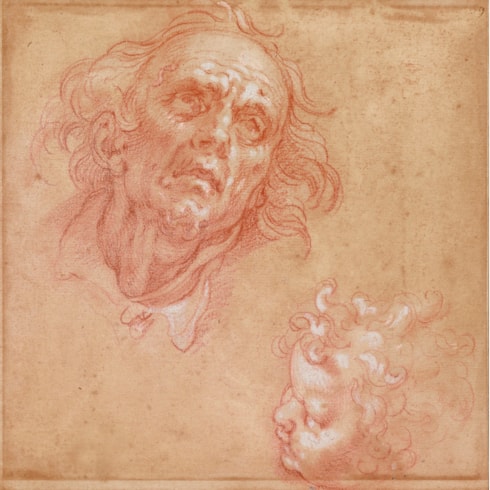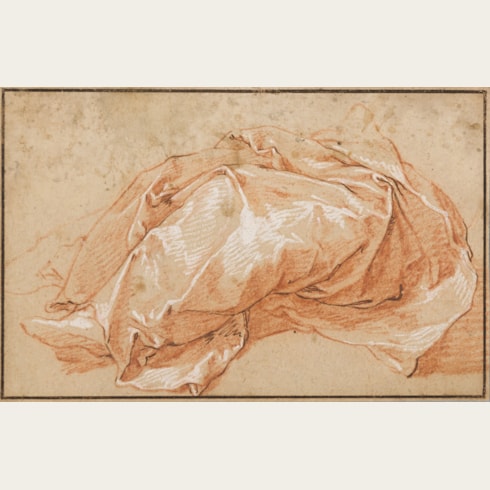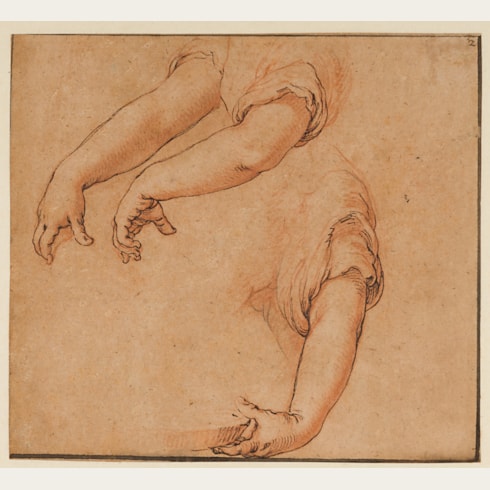Abraham BLOEMAERT
(Gorinchem 1564 - Utrecht 1651)
A Sheet of Animal Studies: An Eagle, a Stork, a Goat and a Donkey
Pen and brown ink and brown wash, over an underdrawing in black chalk.
177 x 144 mm. (7 x 5 5/8 in.)
Sheets of studies such as the present sheet were an integral part of Bloemaert’s working method. The drawing of a standing goat is a preparatory study for the engraving Two Goats and a Goatherd, plate 7 of the Beesten en Vogelen series of fourteen prints of animals, designed by Bloemaert sometime between 1610 and 1615 and engraved and published by his son Frederik in the 1640s or 1650s. A closely related, double-sided pen and ink drawing with three studies of a goat is in the Herbert F. Johnson Museum of Art at Cornell University in Ithaca, New York, while a comparable sheet of studies of goats is in the collection of the Art Institute of Chicago; both drawings are studies for later prints. Another, similar study of goats, drawn in red and black chalk and also preparatory for an engraving, is in the Courtauld Gallery in London.
None of the other animals depicted on the present sheet appear to be studies for engravings, although similar storks appear in a handful of prints designed by Bloemaert.
This drawing bears on the verso the collector’s mark of Paul Eeckhout (1917-2012), a Belgian architect, draughtsman and printmaker who served as a curator at the Museum of Fine Arts in Ghent between 1948 and 1982.
Abraham Bloemaert received his artistic training in Utrecht and Paris but, unlike many of his contemporaries, never travelled to Italy. Indeed, apart from two years in Amsterdam in the early 1590s, he worked in Utrecht from 1583 until his death, at the end of one of the longest careers of any Dutch artist of his era. Almost nothing is known of his work before 1590, however, and it is only after his brief stay in Amsterdam that he began to establish a reputation as an artist of note. Together with Cornelis van Haarlem and Joachim Wtewael, Bloemaert came to be one of the last major exponents of the Northern Mannerist tradition. Among his most important religious works are the altarpieces of God with Christ and the Virgin of 1615 in the Sint Janskerk in ’s-Hertogenbosch and an Adoration of the Magi painted in 1624 for the Jesuit church in Brussels and now in Grenoble. Bloemaert enjoyed a very long and productive career of some sixty years, resulting in an oeuvre of around two hundred extant paintings, including landscapes, religious scenes, history subjects and genre scenes. He was a founding member of the painter’s guild of Saint Luke in Utrecht in 1611, and established a drawing school in Utrecht not long afterwards. As a teacher, Bloemaert’s influence was considerable, with artists such as Jan Both, Cornelis van Poelenburgh, Gerrit van Honthorst, Hendrick Terbrugghen and Jan Baptist Weenix all spending time in his studio.
Bloemaert was a gifted and prolific draughtsman, praised as such by his biographer Karel van Mander, who noted that the artist ‘has a clever way of drawing with a pen, and, by adding small amounts of watercolour, he produces unusual effects’. He produced numerous studies for paintings and engravings - some six hundred prints after his designs are known - as well as several landscape drawings and many sheets of studies of heads, hands and arms. Some of the latter were reproduced as engravings by his son Frederik and published in the 1650s as the Konstryk Tekenboek, a sort of model-book for students. The Tekenboek proved very popular and was reprinted several times, serving to perpetuate Bloemaert’s influence on later generations of artists. (Indeed, the 18th century French artist François Boucher published a series of etchings after Bloemaert’s figure studies, known as the Livre d’etude d’après les desseins originaux de Blomart, which appeared in Paris in 1735.) The bulk of Bloemaert’s enormous corpus of drawings, numbering around 1,700 sheets, appear to have been retained by his descendants for over fifty years, and it is not until the first half of the 18th century that they began to be sold and dispersed.
Provenance
Paul Eeckhout, Ghent (Lugt 824a), his mark on the verso
His (anonymous) sale, London, Phillips, 7 December 1994, lot 90 (as Attributed to Abraham Bloemaert)
W. M. Brady & Co., New York and Thomas Williams, London, in 1995\
Private collection.
Literature
Jaap Bolten, Abraham Bloemaert: The Drawings, Leiden, 2007, Vol.I, p.400, no.1323, Vol.II, p.415, fig.1323 (as location unknown, and dated 1605-1610); Horace Wood Brock, Martin P. Levy and Clifford S. Ackley, Splendor and Elegance: European Decorative Arts and Drawings from the Horace Wood Brock Collection, exhibition catalogue, Boston, 2009, p.156, no.109, illustrated p.111.
Exhibition
New York, W. M. Brady & Co. Inc., and London, Thomas Williams (Fine Art) Ltd. at Daniel Katz Ltd., Old Master Drawings, Autumn 1995, no.13; Stanford University, Cantor Center for Visual Arts, Classic Taste: Drawings and Decorative Arts from the Collection of Horace Brock, March-May, 2000; Boston, Museum of Fine Arts, Splendor and Elegance: European Decorative Arts and Drawings from the Horace Wood Brock Collection, 2009, no.109.











